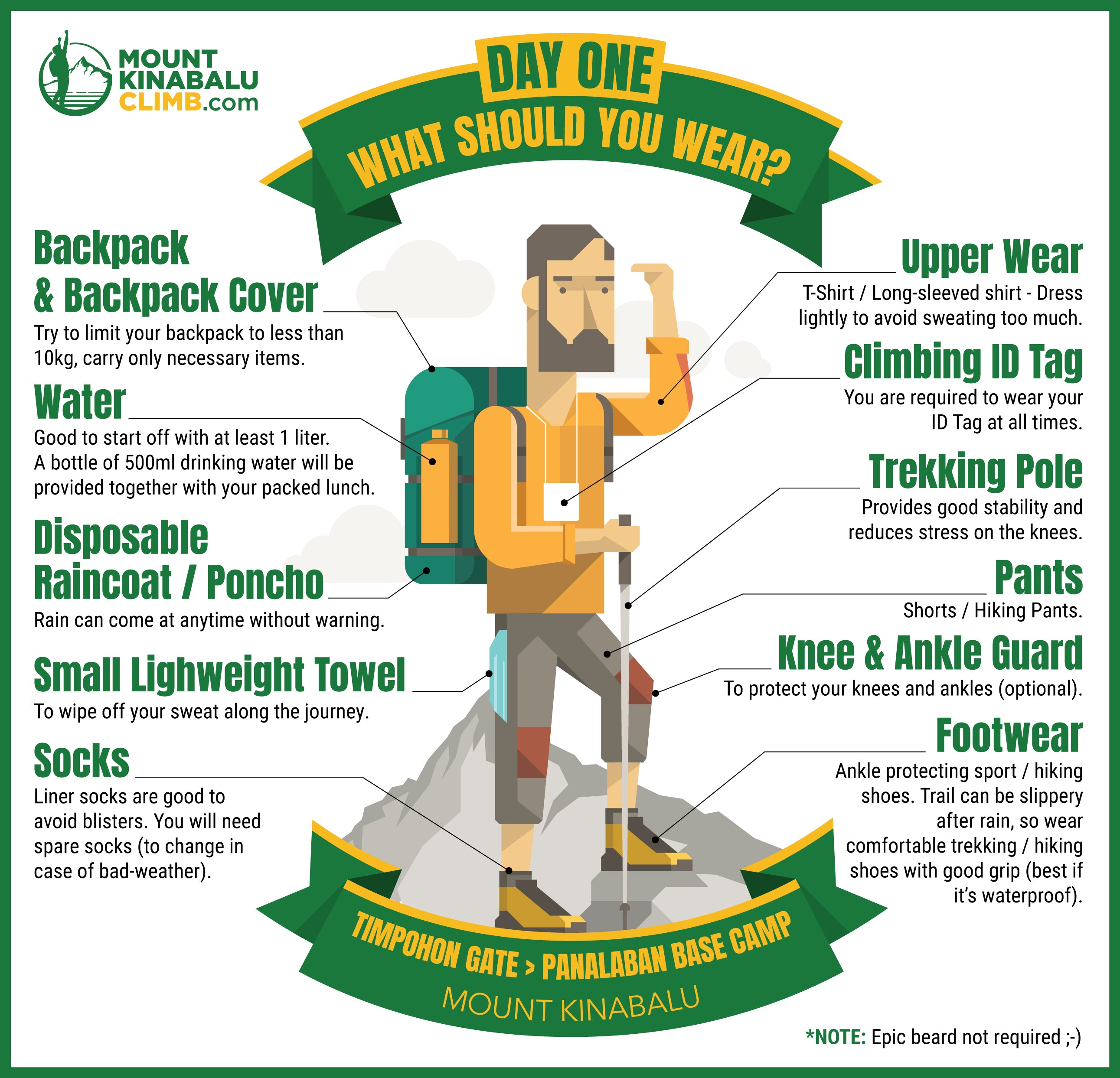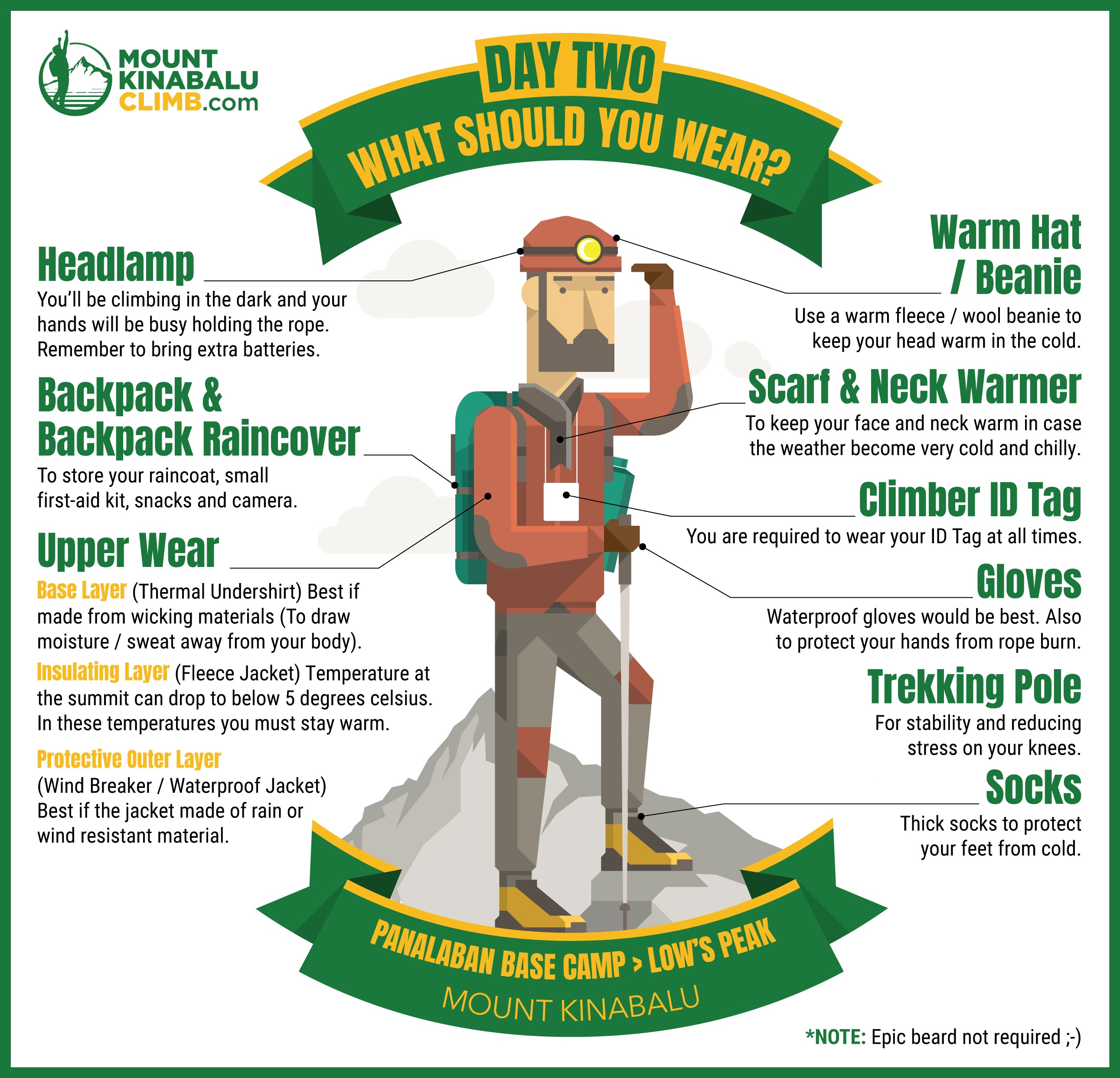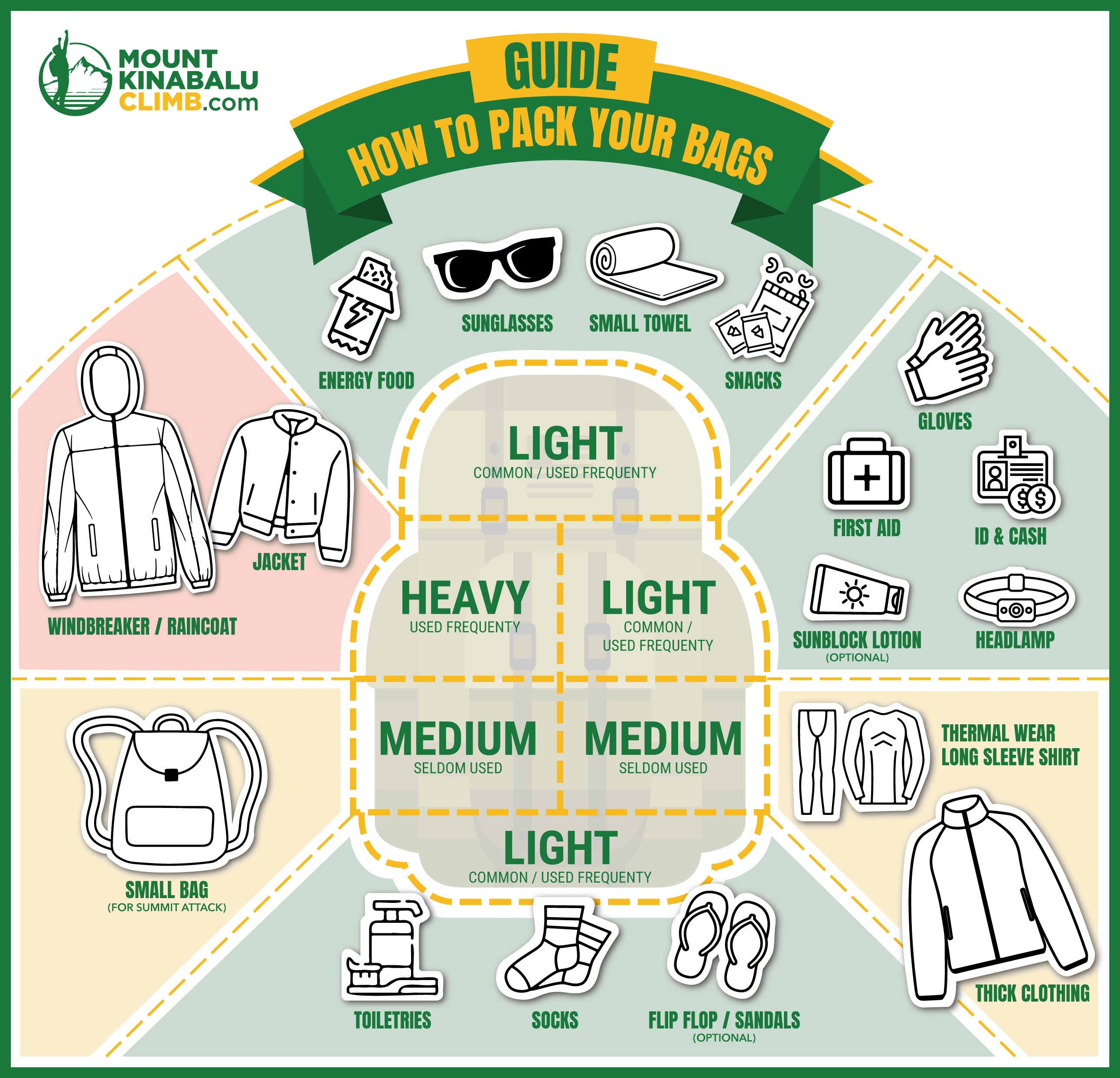What to Prepare
Mount Kinabalu Climb 2024 & 2025
If you're gearing up for a Mount Kinabalu climb, this comprehensive packing list will give you a great idea of what to prepare for maximum comfort and enjoyment. To ensure you make the most out of your adventure, it's essential to think about how to pack your items for a fantastic climbing experience!
In order to climb safely and conveniently, it is essential that you pack in an efficient way with only the necessary items. Temperatures on the mountain can range from warm (up to 23°C during the day) to cold and windy (as low as 3°C during the early hours). Rain can also occur at any point, so be prepared for any weather conditions. Ensure you do not overpack, try to keep the weight of your backpack to not more than 10KG by taking only essential items from the list of things we recommend for the climb. Carrying a heavy load on your back will cause you to lean forward, so try to keep your back straight as often as possible to help evenly distribute your weight and maintain your balance.
DAY CLIMB
- Weather conditions: Usually warm and sunny
- Distance: From Timpohon Gate to Panalaban Base Camp
The weather on Mount Kinabalu is highly unpredictable. Therefore, preparing yourself for cold and rainy conditions during your ascent is wise. What to wear is ultimately up to the individual. Still, you may consider taking a warm jacket with you, as the temperature difference between Timpohon Gate and Panalaban Base Camp can be as much as 10°c. Make sure you bring the necessary items and take a look at the infographic for more tips on clothing for your day climb.

What should you wear?
- Upper Wear: Wear a breathable T-shirt or long-sleeved shirt to prevent excessive perspiration
- Climbing ID tag: You need to keep your ID tag on you for the entire ascent
- Pants: Comfortable shorts or hiking pants
- Knee and ankle braces: To protect your knees and ankles (optional)
- Ankle protecting sport hiking shoes: Trails can become dangerously slick after rainfall, so wear sturdy and waterproof trekking shoes with a good grip
- Backpack & backpack rain cover: Only bring what you need and make sure your backpack doesn't exceed 10kg in weight.
- Socks: Liner socks are good for preventing blisters. You will need spare socks when dealing with bad weather
- Trekking pole: Provide stability for the climbers and reduce pressure on joints on a rough trail
- Water: A 500ml bottle of water will come with your packed lunch, so it is a good idea to begin with at least one litre.
NIGHT CLIMB
- Weather conditions: Usually cold and windy
- Distance: From Panalaban Base Camp to Low’s Peak
The summit ascent for Mount Kinabalu commences between 2:30 to 3:00 a.m. and is usually characterized by chilly and breezy weather. To guarantee comfort and keep your body warm, you should dress in layers. This will enable you to modify your clothing based on your activity level and any weather variations. Any items you don't need for the summit ascent can be left in your room, but make sure not to leave anything valuable.
It is recommended to dress in three layers. The base layer against your skin should be made of materials that wick away moisture for maximum evaporation. Thermal underwear is ideal for the base layer. The insulating layer should be made of a material that traps the warmth produced by your body, such as a fleece jacket. Lastly, the protective/outer layer should be waterproof, windproof and breathable to shield you from the wind and rain, such as a windbreaker or waterproof jacket.

What Should You Wear?
- Warm hat / Beanie: Wear a cosy fleece or wool beanie to keep your head warm in the chilly weather
- Scarf / Neck warmer: To keep your face and neck warm
- Face Mask / Balaclava: To protect lungs from the cold temperatures and strong winds at high altitudes
- Upper wear:
- Base Layer: Best if made of material that wicks away moisture for maximum evaporation such as thermal undershirt
- Insulating Layer: Best if made of material that traps the warmth produced by your body such as fleece jacket
- Protective Outer Layer: Best if made of material that is waterproof, windproof and breathable to shield you from the wind and rain such as windbreaker or waterproof jacket - Climbing ID tag: You need to keep your ID tag on you for the entire ascent
- Glove: A waterproof glove is ideal for keeping your fingers warm in cold weather and protecting your hand from rope
- Pants: Thick hiking pants
- Ankle protecting sport hiking shoes: Wear sturdy and waterproof trekking shoes with a good grip
- Headlamp: You need to ascend in the dark and save your hands for the rope. Remember to bring extra batteries along.
- Backpack & backpack rain cover: To store your raincoat, small first-aid kits, and energy food
- Socks: Thick socks are good for keeping your feet warm
- Trekking pole: Provide stability for the climbers and reduce pressure on joints on a rough trail
- Water: A 500ml bottle of water will come with your packed lunch, so it is a good idea to begin with at least one litre.

What Should You Pack?
- Water: A 500ml bottle of water will come with your packed lunch, so it is a good idea to begin with at least one litre.
- Disposable raincoat/ ponchos: Rain can fall at any moment
- Small, lightweight towel: To wipe off your sweat as you climb
- Energy food: to refuel climbers with sustained energy
- Tissue paper/ toilet paper: Tissue or toilet paper is not supplied in the toilet stops on the way up the mountain or at the toilets of the shelter
- Sunblock lotion, sunglasses, lip balm
- Mini first-aid kits: You might need a bandage and antiseptic cream for an injury, a counter pain or muscle spray for muscle pain, and paracetamol or a vomit pill for altitude sickness
- Personal medication: there is limited access to medical facilities on the climb, so having personal medication on hand can be useful in case of emergency
How to pack for Mount Kinabalu Climb
People planning to climb Mount Kinabalu often wonder, "How should I pack?" Here are some tips to help you pack efficiently and avoid taking too much on your climb.
- Cut down on your electronics by selecting one or two that can fulfil your requirements. Most of the devices can do several tasks. You don't need to take them all with you.
- Refrain from bringing full-sized toiletries. Instead, move necessary items to refillable travel-sized containers.
- Compactly folded clothes take up less room in your backpack.
- Bring versatile personal care items. Pack toiletries that serve multiple purposes, such as a combined shampoo and conditioner, a shampoo bar that can also be used as body wash and shaving cream, and a face lotion that doubles as sunscreen.
- Begin packing ahead of time and ensure you have all the items for Mount Kinabalu by following our Things to bring list. This will prevent you from becoming overwhelmed when packing at the last minute, which often results in a disorganized suitcase and forgetting important items.
